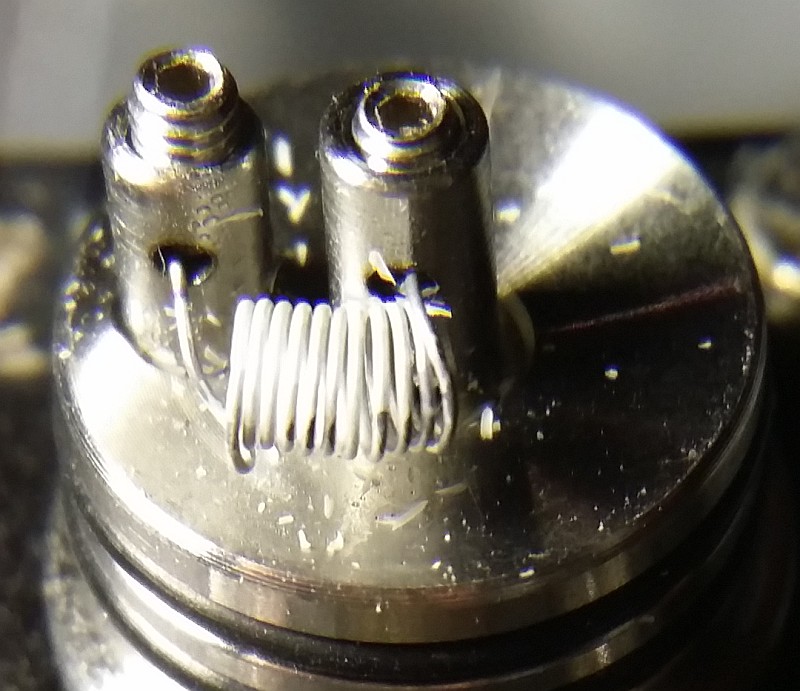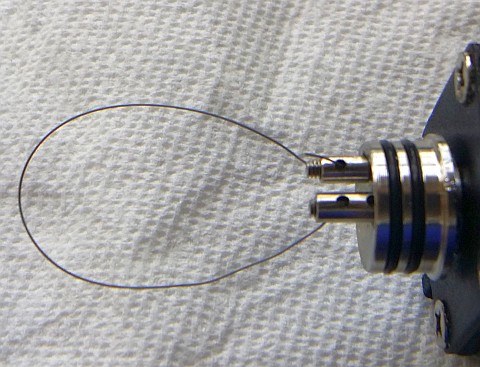The subject of possibly making coils out of titanium wire came up recently in pdib's big thread starting roughly here. pdib himself found some 24 gauge for sale on eBay and asked the seller what the resistance was. He was told it as a bit over 5 ohms per foot, which would have been great, but turned out to be quite wrong; it was under 1 ohm per foot; i.e. too low to be useable. That empirical observation was later confirmed by a chart. Still, I was intrigued enough by the concept to locate and order some 30 gauge, and I finally got to playing with that. The results are not good.
Methodology: I wound a ~2mm ID coil on a 5/64" bit. Thinking it would have resistance per unit length roughly equivalent to 25 gauge Kanthal and wanting to start at a relatively high resistance, I was shooting for 12 wraps, but it was springy enough that I ended up with 11, and they weren't in tight contact with each other. I mounted it on a Cyclone base and screwed it onto a dna mod set to a conservative 10 watts. A couple of quick taps of on the fire button produce readings of 1.4 to 1.5 ohms. That seemed promising, so the taps became presses and holds while visually observing how it heated. Very unevenly. OK, time to break out the ceramic-tipped tweezers and squeeze it together while heating it. This resulted in resistance readings that went as low as 1.1 ohms and as high as 2.4-2.5. So I figured it was shorting coil-to-coil in places, so I'll try to spread it out evenly. Well, when I started to spread it out, I noticed that the light colored oxide layer that had started to form in it readily came off where I was manipulating it with the tweezers. That's bad. Here's a picture:

Conclusion: I think it could be used in pinch if it were wound without contact between adjacent coils and it was kept wet at all times while powered. But any attempt to dry burn will form prodigious amounts of titanium dioxide, which does not stay stuck to the coil like the oxide layer on Kanthal seems to. Moreover, it's a real PITA to get it to glow at all evenly. So for the time being, I'll stick with Kanthal, Nichrome, or if I'm feeling masochistic, R41.
=-=-=-=-=
Update: I decided to play with it some more. I made a loop about 3" long. Cold, it reads 1.2-1.3Ω. As it heats up, the readings rise to roughly double that. They return to the original value when the wire is allowed to cool again.
As before, I'm firing that at 10 watts. With a loop in open air, gets it only hot enough to glow dull red. I have no way to measure the wire temperature other than describing the color that it glows. It seems dull red is not hot enough to form the white oxide; instead the wire seems to have turned a bit blue. This is it after having been fired at 10 watts quite a bit:

A couple of other observations in this configuration: Blowing on the wire while firing it cools it enough to drop the resistance noticeably. Firing the same loop on a mech at a constant voltage (roughly 4.02V -- measured in-line) produces almost no visible glow. Back on the DNA with the power dialed up to 15W brings the resistance up to around 2.8Ω and produces a bright orange glow -- as well as white oxide formation. Turning it up to 20W pushes the resistance beyond the DNA's 3.0Ω limit at which point it stops firing and reads "Check Atomizer".
More conclusions:
There's some critical temperature below which white oxide formation doesn't occur. Titanium wire has a substantial positive temperature coefficient which tends to limit power a device that operates as a voltage source (such as a mech). Titanium is probably more suitable for a mech than for a device that produces constant power. It might usable on mech if wound into a non-contact coil configuration, such as one would traditionally do with silica as a wick. I'm tempted to try this, but don't have any silica handy at the moment. I'm confident it's not going to form white oxide while wet with juice. Whether it's practical to use or not depends whether it can be dry burned once its gunked up. Throwing away a coil every time it gets gunked up would be plain silly.
Methodology: I wound a ~2mm ID coil on a 5/64" bit. Thinking it would have resistance per unit length roughly equivalent to 25 gauge Kanthal and wanting to start at a relatively high resistance, I was shooting for 12 wraps, but it was springy enough that I ended up with 11, and they weren't in tight contact with each other. I mounted it on a Cyclone base and screwed it onto a dna mod set to a conservative 10 watts. A couple of quick taps of on the fire button produce readings of 1.4 to 1.5 ohms. That seemed promising, so the taps became presses and holds while visually observing how it heated. Very unevenly. OK, time to break out the ceramic-tipped tweezers and squeeze it together while heating it. This resulted in resistance readings that went as low as 1.1 ohms and as high as 2.4-2.5. So I figured it was shorting coil-to-coil in places, so I'll try to spread it out evenly. Well, when I started to spread it out, I noticed that the light colored oxide layer that had started to form in it readily came off where I was manipulating it with the tweezers. That's bad. Here's a picture:

Conclusion: I think it could be used in pinch if it were wound without contact between adjacent coils and it was kept wet at all times while powered. But any attempt to dry burn will form prodigious amounts of titanium dioxide, which does not stay stuck to the coil like the oxide layer on Kanthal seems to. Moreover, it's a real PITA to get it to glow at all evenly. So for the time being, I'll stick with Kanthal, Nichrome, or if I'm feeling masochistic, R41.
=-=-=-=-=
Update: I decided to play with it some more. I made a loop about 3" long. Cold, it reads 1.2-1.3Ω. As it heats up, the readings rise to roughly double that. They return to the original value when the wire is allowed to cool again.
As before, I'm firing that at 10 watts. With a loop in open air, gets it only hot enough to glow dull red. I have no way to measure the wire temperature other than describing the color that it glows. It seems dull red is not hot enough to form the white oxide; instead the wire seems to have turned a bit blue. This is it after having been fired at 10 watts quite a bit:

A couple of other observations in this configuration: Blowing on the wire while firing it cools it enough to drop the resistance noticeably. Firing the same loop on a mech at a constant voltage (roughly 4.02V -- measured in-line) produces almost no visible glow. Back on the DNA with the power dialed up to 15W brings the resistance up to around 2.8Ω and produces a bright orange glow -- as well as white oxide formation. Turning it up to 20W pushes the resistance beyond the DNA's 3.0Ω limit at which point it stops firing and reads "Check Atomizer".
More conclusions:
There's some critical temperature below which white oxide formation doesn't occur. Titanium wire has a substantial positive temperature coefficient which tends to limit power a device that operates as a voltage source (such as a mech). Titanium is probably more suitable for a mech than for a device that produces constant power. It might usable on mech if wound into a non-contact coil configuration, such as one would traditionally do with silica as a wick. I'm tempted to try this, but don't have any silica handy at the moment. I'm confident it's not going to form white oxide while wet with juice. Whether it's practical to use or not depends whether it can be dry burned once its gunked up. Throwing away a coil every time it gets gunked up would be plain silly.
